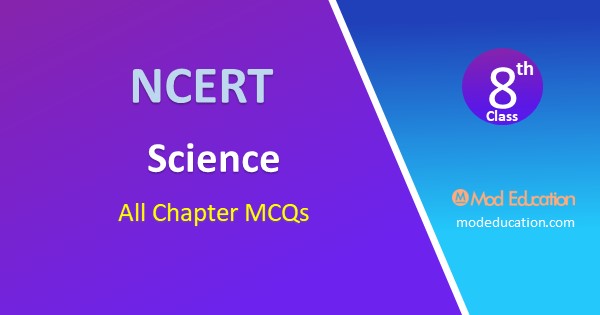MCQ Questions for Class 8 Science Chapter 17 : NCERT CBSE RBSE other Board MCQ Questions for Class 8 Science Chapter 17 Stars and the Solar System with Answers Pdf free download. MCQ Questions for Class 8 Science with Answers were prepared based on the latest exam pattern.

MCQ Questions for Class 8 Science Chapter 17 Stars and the Solar System with Answers
Question 1.
Which of the following does not belong to the family of solar system?
(a) Planet
(b) Galaxy
(c) Meteors
(d) Comet
Answer: (b) Galaxy
Question 2.
The Halley’s Comet is seen after every
(a) 76 months
(b) 76 years
(c) 56 months
(d) 56 years
Answer: (b) 76 years
Question 3.
Ursa Major is a
(a) star
(b) constellation
(c) seen only with telescope
(d) satellite
Answer: (b) constellation
Question 4.
Which planet has the largest number of satellites?
(a) Jupiter
(b) Saturn
(c) Mercury
(d) Mars
Answer: (b) Saturn
Question 5.
Which unit is used to measure astronomical distances?
(a) Leap year
(b) Light year
(c) Century
(d) Sound year
Answer: (b) Light year
Question 6.
The stars forming a recognizable shape is called
(a) constellation
(b) system
(c) galaxy
(d) asteroids
Answer: (a) constellation
Question 7.
Which star is nearest to Earth?
(a) Pole star
(c) Orion
(b) Cassiopeia
(d) Sun
Answer: (d) Sun
Question 8.
What term is used for celestial bodies that revolve around the Sun in highly elliptical orbit?
(a) Comet
(b) Meteors
(c) Asteroids
(d) Planets
Answer: (a) Comet
Question 9.
Which small objects revolve between the orbits of Mars and Jupiter?
(a) Satellites
(b) Comets
(c) Asteroids
(d) Meteorites
Answer: (c) Asteroids
Question 10.
Which planet is called morning star or evening star?
(a) Venus
(b) Mars
(c) Jupiter
(d) Mercury
Answer: (a) Venus
Q11. The stars forming a recognizable shape is called
(a) constellation
(b) system
(c) galaxy
(d) asteroids
Answer: (a) constellation
Q12. Which of the following is not inner planet:
(a) Mercury
(b) Jupiter
(c) Mars
(d) Earth
Answer: (b) Jupiter
Q13. Which star is nearest to Earth?
(a) Pole star
(c) Orion
(b) Cassiopeia
(d) Sun
Answer: (d) Sun
Q14. Which of the following Is not outer planet:
(a) Venus
(b) Saturn
(c) Uranus
(d) Neptune
Answer: (a) Venus
Q15. What term is used for celestial bodies that revolve around the Sun in highly elliptical orbit?
(a) Comet
(b) Meteors
(c) Asteroids
(d) Planets
Answer: (a) Comet
Q16. Halley’s comet appear after nearly:
(a) 75 years
(b) 76 years
(c) 76 months
(d) None of these
Answer: (b) 76 years
Q17. Which small objects revolve between the orbits of Mars and Jupiter?
(a) Satellites
(b) Comets
(c) Asteroids
(d) Meteorites
Answer: (c) Asteroids
Q18. Shooting stars are:
(a) Stars
(b) Planets
(c) Meteors
(d) Nope of these
Answer: (c) Meteors
Q19. Which planet is called morning star or evening star?
(a) Venus
(b) Mars
(c) Jupiter
(d) Mercury
Answer: (a) Venus
Q20. Asteroids are seen between the orbits of:
(a) Mercury and Earth
(b) Mais and Jupiter
(c) Earth and Mars
(d) Nne of these
Answer: (b) Mais and Jupiter
Match the following items given in Column A with that in Column ‘B’:
| Column A | Column B |
| (i) Nearest of the Sun | (a) Jupiter |
| (ii) Largest planet | (b) Star |
| (iii) Comets | (c) Artificial satellites |
| (iv) Alpha Centauri | (d) A constellation |
| (v) INSAT 3E | (e) Other than planets |
| (vi) Ursa major | (f) Neptune |
| (vii) Planet | (g) Mercury |
Answer:
| Column A | Column B |
| (i) Nearest of the Sun | (g) Mercury |
| (ii) Largest planet | (a) Jupiter |
| (iii) Comets | (e) Other than planets |
| (iv) Alpha Centauri | (b) Star |
| (v) INSAT 3E | (c) Artificial satellites |
| (vi) Ursa major | (d) A constellation |
| (vii) Planet | (f) Neptune |
